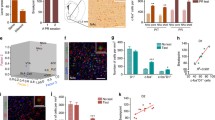Abstract
The brain reward circuit is complex and it plays an important role in reward-motivated behavior and is fundamental for species survival. It is also implicated in several diseases that involve motivational deficits such as depression and schizophrenia. Due to its complex circuitry involving differential sub-neuronal populations and glia, traditional lesioning, and pharmacological manipulations have failed to differentiate the effect of these complex, intermingled circuitry. Designer receptors exclusively activated by designer drugs (DREADDs) provide a minimally invasive option to circumvent these issues. In this chapter, we address the method by which DREADD is applied in behavioral neuroscience to explore the brain reward circuit in our laboratory. We highlight the potential difficulties faced by new users of this technology and provide some of our methods to overcome them. When used properly, the DREADD system is a versatile tool to interrogate circuits and brain areas associated with reward-motivated behavior and thus is a valuable addition to any behavioral neuroscientist’s methodological toolbox.
Access this chapter
Tax calculation will be finalised at checkout
Purchases are for personal use only
Similar content being viewed by others
References
Russo SJ, Nestler EJ (2013) The brain reward circuitry in mood disorders. Nat Rev Neurosci 14:609–625
Dichter GS, Damiano CA, Allen JA (2012) Reward circuitry dysfunction in psychiatric and neurodevelopmental disorders and genetic syndromes: animal models and clinical findings. J Neurodev Disord. https://doi.org/10.1186/1866-1955-4-19
Kelley AE, Berridge KC (2002) The neuroscience of natural rewards: relevance to addictive drugs. J Neurosci 22:3306–3311
Cooper S, Robison AJ, Mazei-Robison MS (2017) Reward Circuitry in Addiction. Neurotherapeutics 14:687–697
Simpson EH, Balsam PD (2016) Behavioral neuroscience of motivation. Springer, Switzerland
Balleine B, Killcross S (1994) Effects of ibotenic acid lesions of the nucleus accumbens on instrumental action. Behav Brain Res 65:181–193
Balleine BW, Delgado MR, Hikosaka O (2007) The role of the dorsal striatum in reward and decision-making. J Neurosci 27:8161–8165
Blaiss CA, Janak PH (2009) The nucleus accumbens core and shell are critical for the expression, but not the consolidation, of Pavlovian conditioned approach. Behav Brain Res 200:22–32
Cassataro D et al (2013) Reverse pharmacogenetic modulation of the nucleus accumbens reduces ethanol consumption in a limited access paradigm. Neuropsychopharmacology 39:283–290
Hernandez PJ, Sadeghian K, Kelley AE (2002) Early consolidation of instrumental learning requires protein synthesis in the nucleus accumbens. Nat Neurosci 5:1327–1331
Parkinson JA et al (1999) Dissociation in effects of lesions of the nucleus accumbens core and shell on appetitive pavlovian approach behavior and the potentiation of conditioned reinforcement and locomotor activity byd-amphetamine. J Neurosci 19:2401–2411
Ward RD et al (2015) Orbitofrontal cortex mediates the differential impact of signaled-reward probability on discrimination accuracy. Front Neurosci 9:230. https://doi.org/10.3389/fnins.2015.00230
Hall-McMaster S et al (2017) Medial orbitofrontal cortex modulates associative learning between environmental cues and reward probability. Behav Neurosci 131:1–10
Robbins T (2002) The 5-choice serial reaction time task: behavioural pharmacology and functional neurochemistry. Psychopharmacology 163:362–380
Kelley AE et al (2005) Corticostriatal-hypothalamic circuitry and food motivation: integration of energy, action and reward. Physiol Behav 86:773–795
Cox J, Witten IB (2019) Striatal circuits for reward learning and decision-making. Nat Rev Neurosci 1:482–494
Bressan RA, Crippa JA (2005) The role of dopamine in reward and pleasure behaviour–review of data from preclinical research. Acta Psychiatr Scand 111:14–21
Sesack SR, Grace AA (2010) Cortico-basal ganglia reward network: microcircuitry. Neuropsychopharmacology 35:27–47
Simon NW, Moghaddam B (2015) Neural processing of reward in adolescent rodents. Dev Cogn Neurosci 11:145–154
Robbins TW, Everitt BJ (1996) Neurobehavioural mechanisms of reward and motivation. Curr Opin Neurobiol 6:228–236
Kelley AE (2004) Ventral striatal control of appetitive motivation: role in ingestive behavior and reward-related learning. Neurosci Biobehav Rev 27:765–776
Armbruster BN et al (2007) Evolving the lock to fit the key to create a family of G protein-coupled receptors potently activated by an inert ligand. PNAS 104:5163–5168
Campbell EJ, Marchant NJ (2018) The use of chemogenetics in behavioural neuroscience: receptor variants, targeting approaches and caveats. Br J Pharmacol 175:994–1003
Smith KS et al (2016) DREADDS: use and application in behavioral neuroscience. Behav Neurosci 130:137–155
Roth BL (2016) DREADDs for neuroscientists. Neuron 89:683–694
Zhu H, Roth BL (2014) Silencing synapses with DREADDs. Neuron 82:723–725
Paxinos G, Watson C (2006) The rat brain in stereotaxic coordinates: hard cover edition. Elsevier
Cetin A et al (2006) Stereotaxic gene delivery in the rodent brain. Nat Protoc 1:3166–3173
Manvich DF et al (2018) The DREADD agonist clozapine N-oxide (CNO) is reverse-metabolized to clozapine and produces clozapine-like interoceptive stimulus effects in rats and mice. Sci Rep 8:3840. https://doi.org/10.1038/s41598-018-22116-z
MacLaren DA et al (2016) Clozapine N-oxide administration produces behavioral effects in Long-Evans rats: implications for designing DREADD experiments. eNeuro. https://doi.org/10.1523/ENEURO.0219-16.2016
Kügler S, Kilic E, Bähr M (2003) Human synapsin 1 gene promoter confers highly neuron-specific long-term transgene expression from an adenoviral vector in the adult rat brain depending on the transduced area. Gene Ther 10:337–347
Author information
Authors and Affiliations
Corresponding author
Editor information
Editors and Affiliations
Rights and permissions
Copyright information
© 2021 Springer Science+Business Media, LLC, part of Springer Nature
About this protocol
Cite this protocol
Pattabhiraman, H., Ward, R.D. (2021). Chemogenetic (DREADD) Exploration of Circuits Mediating Reward-Motivated Attention. In: Fakhoury, M. (eds) The Brain Reward System. Neuromethods, vol 165. Humana, New York, NY. https://doi.org/10.1007/978-1-0716-1146-3_9
Download citation
DOI: https://doi.org/10.1007/978-1-0716-1146-3_9
Published:
Publisher Name: Humana, New York, NY
Print ISBN: 978-1-0716-1145-6
Online ISBN: 978-1-0716-1146-3
eBook Packages: Springer Protocols




